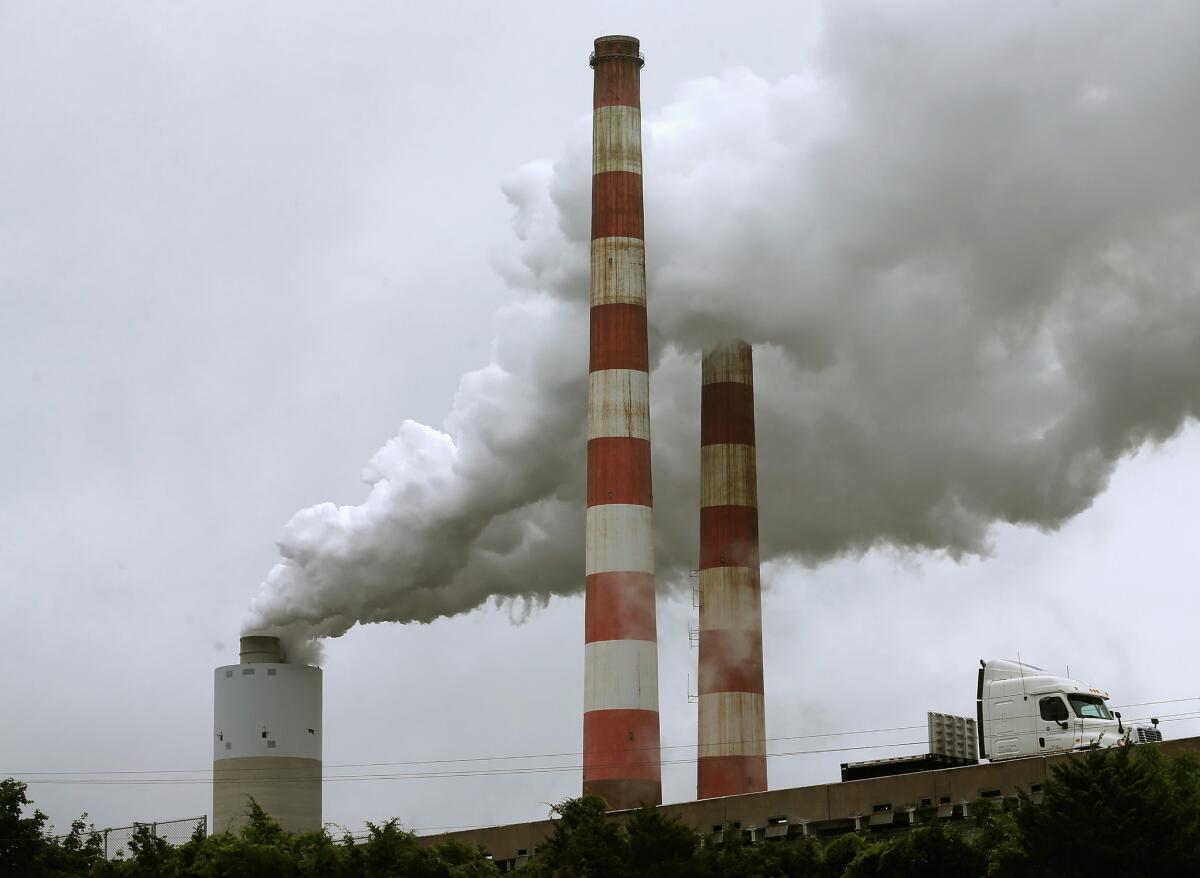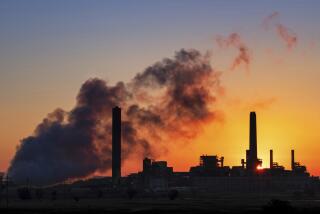Next step for Obama’s climate rules: A court debate over wording ‘glitch’

Over the next 15 years, President Obama’s emissions plan aims to sharply reduce the use of coal and ramp up the use of wind and solar power.
Reporting from Washington — President Obama’s climate-change plan will face a fierce challenge in the courts this fall, when lawyers for at least 15 states join the coal and power industries to block the carbon-reducing rules before they take effect.
They will argue the 1970s-era Clean Air Act did not authorize a national attack on greenhouse gases, and states should not be forced to begin changing their systems for producing electric power until the legality of Obama’s plan has been upheld by the Supreme Court.
The case could feature another legal battle over a wording “glitch,” similar to one just fought over the Affordable Care Act, and a dispute over whether an obscure provision in the 1970s anti-pollution law authorizes a broad 21st century campaign against greenhouse gases.
As he did with the battle over immigration reform, the president is trying to use his regulatory authority to impose sweeping changes without new legislation from Congress.
Critics call it an illegal “power grab.”
That line of attack has worked to a degree on the immigration front. Last year, Obama announced an executive action that would have offered temporary work permits to several million immigrants living here illegally.
But when Texas and 25 other states sued, a federal judge in February blocked Obama’s order from taking effect. In May, a U.S. appeals court upheld that decision, raising the prospect Obama’s order may remain stalled until he leaves the White House.
Lawyers for the coal-dependent states, led by West Virginia, served notice they plan a similar legal attack.
Earlier this year, they filed lawsuits in the U.S. appeals court here even before the Environmental Protection Agency had adopted a final rule for its Clean Power Plan.
They drew a panel with three judges who were Republican appointees, but were told in June that their suit was premature. The lawyers were told to come back and try again once the rule was published as final in the Federal Register. That will take place in a few weeks.
On Monday, West Virginia’s Atty. Gen. Patrick Morrisey denounced the EPA plan as the work of “radical bureaucrats.” It “blatantly disregards the rule of law” and is “based upon an obscure, rarely used provision in the Clean Air Act,” he said.
He referred to a little-used part of the law that said states may be required to set power-plant standards using the “best system of emission reduction.” Previously, this phrase has been understood to mean that a power plant could be required to use the best technology, such as a scrubber or another device, to reduce its smokestack pollution.
But in the new regulation, the EPA relies on a much broader interpretation to require states to adopt a systemwide approach to reducing carbon pollution by, for example, switching to natural gas or adding new solar and wind power. These are sometimes described as “outside the fence” solutions because they go beyond the power plan itself.
The White House described its new rule as “fair and flexible” because it allows states to find their own best way to reduce greenhouse gases. The EPA plan calls for a 32% reduction in carbon pollution by 2030. They are the first limits on carbon pollution from power plants.
But coal-dependent states will argue that the 1970 law only authorized limits on specific “sources” of pollution, not statewide limits enforced from Washington.
The impending legal battle will again feature a discussion of “glitches” and “drafting errors,” setting up a potential replay of this year’s Supreme Court fight over a five-word phrase in the Affordable Care Act.
When Congress amended the Clean Air Act in 1990, House and Senate lawmakers passed slightly different versions of one amendment. And somehow both ended up in the final version of the law.
One version seems to say that if power plants are regulated for hazardous pollutants, they may not be regulated separately through the state plans. The other version seems to say that pollutants like mercury can be regulated only once.
The EPA relies on the second version and argues that since greenhouse gases have not been regulated before, they can be regulated through state plans. The challengers say EPA is relying on a glitch in the law.
Alerted to the upcoming legal battle, EPA made several late changes to its rules that could improve their prospects in court.
The agency pushed back by two years to 2018 when states must submit a final plan to comply. This will make it harder for the coal-dependent states to convince judges they face an “imminent” and “irreparable harm” if the new rules go into effect.
Environmentalists are confident the rules will survive. The Supreme Court agreed by a 5-4 vote in 2007 that greenhouse gases could be regulated as “air pollutants” under the Clean Air Act because they could “endanger the public welfare,” as the law put it.
But other experts in environmental law say the outcome is hard to predict. “EPA will not have smooth sailing,” said Harvard Law professor Richard Lazarus, noting the high court’s June ruling against another clean-air rule came as a “dose of cold water” for environmental advocates.
Former Justice Department lawyer Thomas Lorenzen, who now represents some utilities, described EPA’s new rule as “ambitious and untested.”
“Whether you are for or against it, it’s legally risky. It’s a novel application of a rarely used provision of the act,” Lorenzen said.
The challengers will ask the Washington circuit court to put the rule on hold this fall while the litigation moves forward. If that move fails, they will probably seek a stay from the Supreme Court.
In the end, whether this fall or a year or two from now, the outcome will probably turn on a close vote in the high court.
“The hardest legal issue for EPA is, honestly, how the whole plan is viewed by the swing vote,” said UCLA law professor Ann Carlson, referring to Justice Anthony M. Kennedy.
He cast a fifth vote in 2007 to uphold the initial attack on greenhouse gases, but he also cast a fifth vote in June to block EPA’s costly regulations of mercury and other hazardous pollutants.
“My guess is that EPA will be upheld, but it’s a bit of a wild card,” she said.
Twitter: @DavidGSavage
More to Read
Sign up for Essential California
The most important California stories and recommendations in your inbox every morning.
You may occasionally receive promotional content from the Los Angeles Times.











